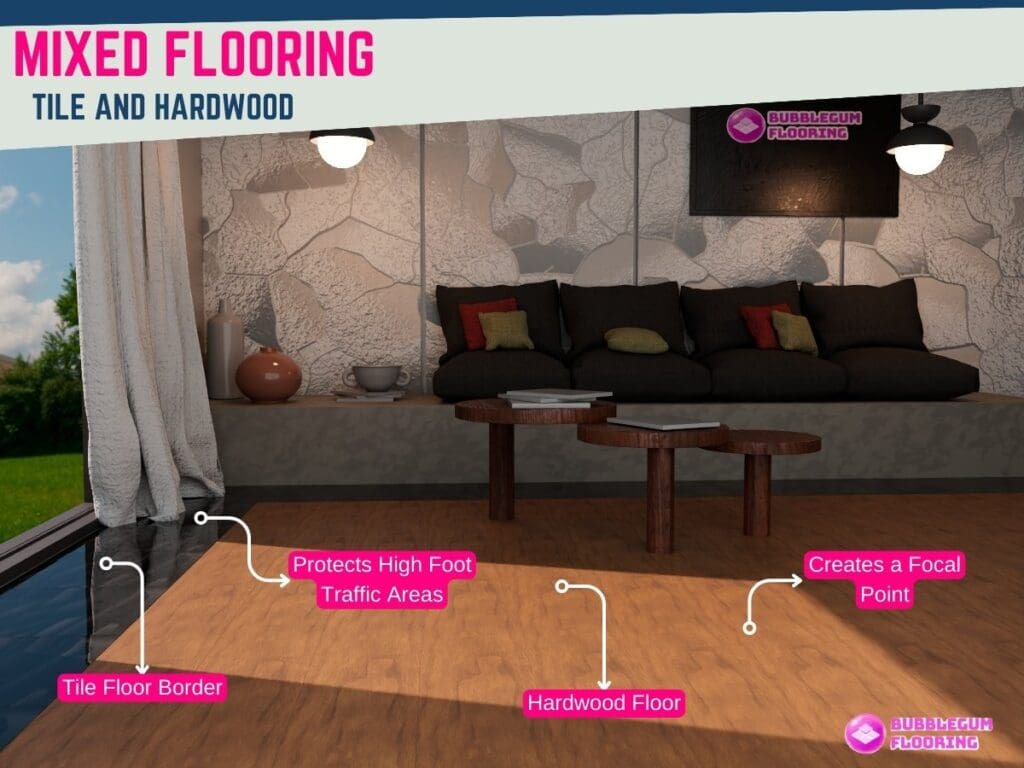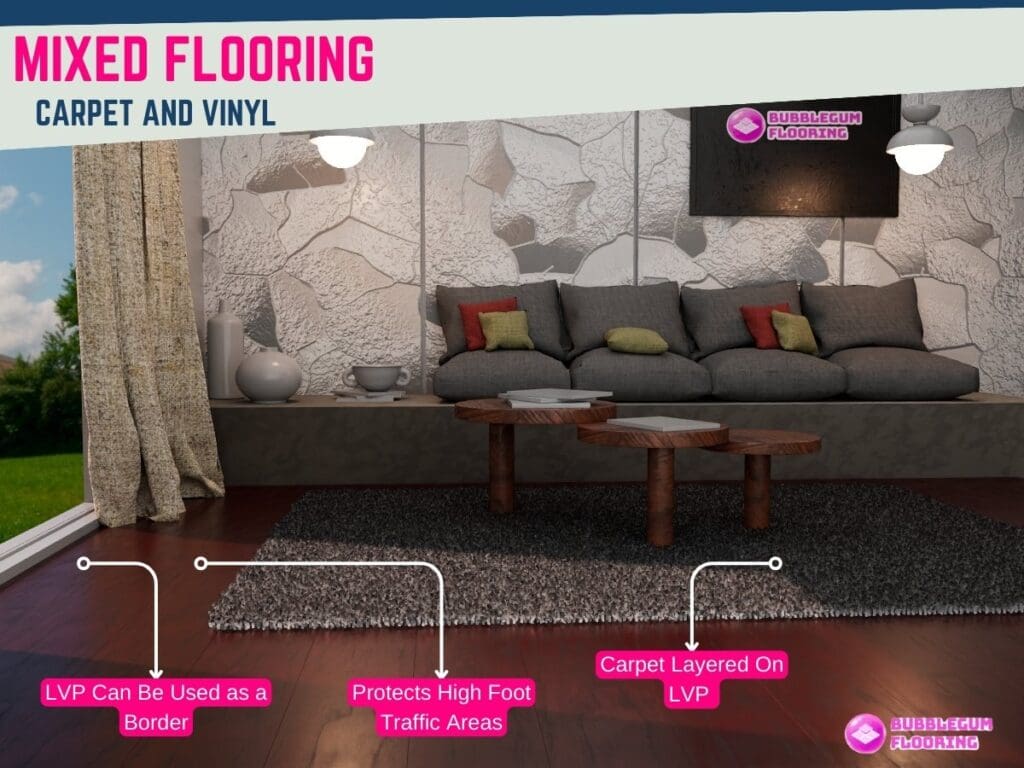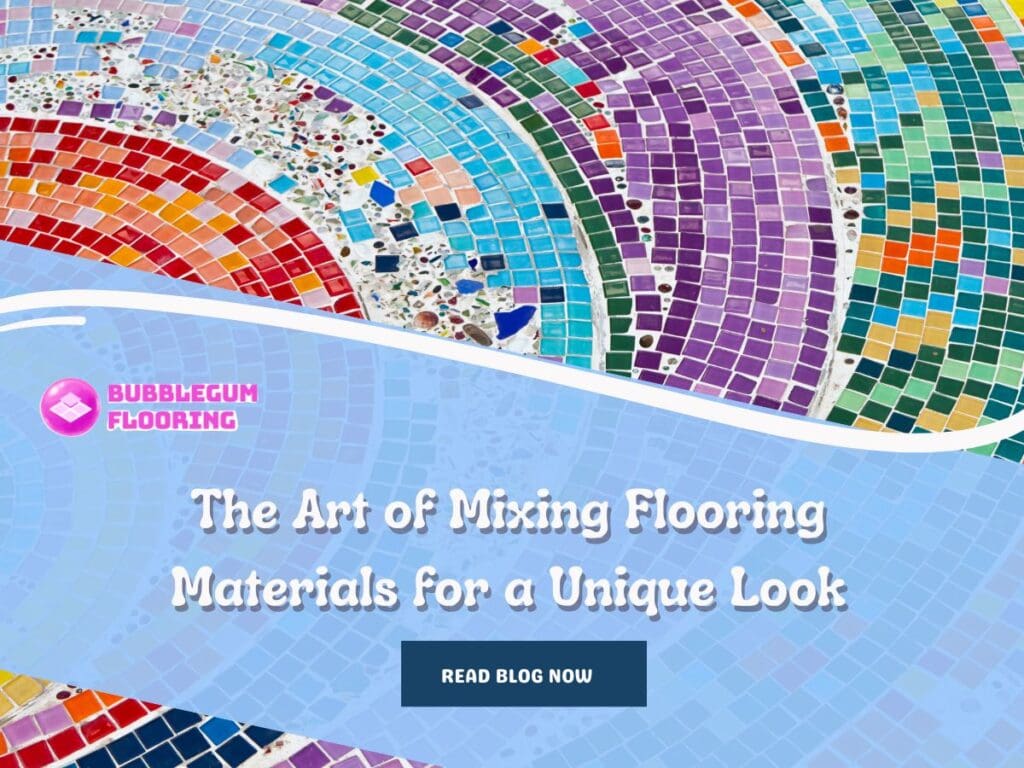Flooring is often the unsung hero of home design, providing a foundation for the entire aesthetic of a room. However, it’s easy to overlook the potential for creativity and personal expression that lies in the choice of flooring materials.
By mixing and matching different textures, colors, and styles, homeowners can create a truly one-of-a-kind look that reflects their unique taste and personality. Discover the transformative power of mixing flooring materials to elevate your space’s aesthetic.
In this blog, we will delve into the art of mixing flooring materials for a unique look by blending textures, finishes, and materials, offering expert tips on achieving a harmonious and visually striking design. From contrasting smooth and distressed wood surfaces to incorporating unexpected elements like concrete and metal, we explore how thoughtful combinations can add depth and character to your floors.
Combining Hardwood and Tile
Combining hardwood and tile flooring is a versatile and visually appealing design choice that can enhance the aesthetic appeal and functionality of any space. This approach allows homeowners to leverage the unique benefits of each material while creating a cohesive and stylish look throughout the home.
Combining hardwood and tile flooring offers a harmonious blend of natural warmth and robust durability. Hardwood exudes timeless elegance, inviting a sense of coziness and sophistication into any space.

On the other hand, tile provides exceptional durability, making it ideal for high-traffic areas or rooms prone to moisture. By juxtaposing these two materials, homeowners can enjoy the best of both worlds, creating a flooring solution that is both aesthetically pleasing and practical.
One creative way to integrate hardwood and tile flooring is by laying a tile border or inlay to accentuate the beauty of the hardwood. This design technique adds visual interest and depth to the flooring, elevating its overall appearance.
A carefully chosen tile border or inlay can serve as a decorative element, enhancing the natural beauty of the hardwood and creating a focal point within the room. Whether opting for a simple border or a more intricate design, this approach allows homeowners to customize their flooring to suit their personal style and preferences.
In spaces where hardwood flooring transitions to tile, using tile as a transition element can provide a seamless and visually appealing divide between rooms. This transition not only serves a functional purpose by delineating different areas of the home but also contributes to the overall flow and continuity of the space.
By carefully selecting tile that complements the hardwood flooring, homeowners can achieve a cohesive look that ties the rooms together harmoniously. Whether opting for a gradual transition or a more distinct separation, using tile as a transition element adds both style and practicality to the home’s design.
Blending Carpet and Luxury Vinyl Plank
Blending carpet with luxury vinyl plank (LVP) flooring can create a unique and stylish look in any space. This design strategy combines the plush comfort of carpet with the durability and realistic look of LVP, offering both aesthetic appeal and practicality.

Layering Plush Carpet with LVP
One way to blend carpet and LVP is to layer them in different areas of a room. For example, you can use plush carpet in areas where comfort is a priority, such as bedrooms or living rooms, while opting for LVP in areas that require more durability, such as hallways or entryways. This combination allows you to enjoy the softness of carpet without sacrificing the durability of LVP.
Using LVP as a Border or Accent
Another design option is to use LVP as a border or accent to define spaces within a room. For instance, you can use LVP to create a border around a seating area or dining area, adding visual interest and creating a cohesive look.
This approach allows you to incorporate both materials in a way that complements each other, enhancing the overall design of the space.
Incorporating LVP in High-Traffic Areas
Incorporating LVP in high-traffic areas while keeping carpet in low-traffic zones is a practical approach to blending these two materials. LVP is known for its durability and resistance to scratches and dents, making it ideal for areas that see a lot of foot traffic.
By using LVP in these areas and carpet in less frequently used areas, you can ensure that your flooring remains both beautiful and functional.
Incorporating Natural Stone in Interior Design
Natural stone is a timeless element that adds elegance, texture, and character to interior spaces. Whether it’s the rustic charm of slate, the luxurious appeal of marble, or the earthy warmth of travertine, incorporating natural stone into your home can elevate its aesthetic and create a sense of harmony with the environment.
There are creative ways to integrate natural stone into interior design, such as pairing it with wood-look flooring, using it as a focal point or accent, and combining different types of stone for a unique mosaic effect.
Pairing Natural Stone Tiles with Wood-Look Flooring
Combining natural stone tiles with wood-look flooring creates a striking juxtaposition of textures and colors, adding depth and visual interest to any space. This pairing works particularly well in areas such as kitchens, bathrooms, and entryways, where durability and style are essential.
Combining the rugged beauty of natural stone with the warmth of wood results in an enhanced aesthetic appeal. The contrast between these materials creates a visually captivating atmosphere, adding depth and character to any space. This blend of textures and colors offers a unique and inviting ambiance that can elevate the overall design of a room.
Both natural stone and wood-look flooring are known for their durability and longevity. These materials are built to withstand heavy foot traffic and daily wear and tear, requiring minimal maintenance over time. Their resilience ensures that they can maintain their pristine appearance for years to come, making them a practical choice for residential and commercial spaces alike.
The versatility of this combination allows for a wide range of design possibilities. Whether you prefer a rustic, traditional look or a more contemporary aesthetic, the marriage of natural stone and wood flooring can seamlessly complement various interior styles. This flexibility provides homeowners and designers with the freedom to experiment and create spaces that reflect their unique tastes and preferences.
Below are tips for Pairing Natural Stone with Wood-Look Flooring:
- Choose Complementary Colors: Select stone tiles that complement the hues of the wood flooring to create a cohesive look. For instance, pairing gray slate with light oak flooring can create a modern yet natural ambiance.
- Consider Textural Contrast: Opt for contrasting textures between the stone and wood to enhance visual interest. Smooth marble tiles can contrast beautifully with the textured grain of wood-look flooring.
- Use Transition Pieces: Incorporate transition pieces, such as metal or wood thresholds, to seamlessly blend the two flooring materials and prevent tripping hazards.
- Balance Proportions: Maintain visual balance by considering the proportions of each material. For example, larger stone tiles may require narrower wood planks to prevent overwhelming the space.
Using Stone as a Focal Point or Accent in a Room
Natural stone can serve as a captivating focal point or subtle accent in various rooms, adding character and sophistication to the interior design scheme. Whether it’s a grand fireplace surround, a statement wall, or elegant countertops, incorporating stone elements can elevate the overall ambiance of the space.
Combining Different Types of Natural Stone for a Unique Mosaic Effect
Creating a mosaic effect by combining different types of natural stone allows for endless creativity and customization in interior design. Whether it’s a mosaic tile backsplash, a decorative floor pattern, or an artistic wall mural, blending various stones can result in visually stunning and personalized spaces.
Mixing Textures and Finishes
In the realm of interior design, the art of mixing flooring materials has emerged as a trend that adds character and depth to spaces. One of the key elements in this practice is the deliberate combination of textures and finishes.
By juxtaposing different textures, such as smooth and distressed wood surfaces, designers can create a dynamic visual contrast that adds interest to the floor. This technique not only creates a more visually appealing space but also adds a tactile element, inviting touch and interaction.
Contrasting Smooth and Distressed Wood Surfaces
A popular approach to mixing flooring materials is to contrast smooth and distressed wood surfaces. Smooth wood surfaces, with their refined and uniform appearance, can create a sense of elegance and sophistication.
In contrast, distressed wood surfaces, with their worn and weathered look, add a touch of rustic charm and warmth to a space. By combining these two textures, designers can achieve a balance that is both visually striking and inviting.
Blending Matte and Glossy Finishes for Visual Depth
Another effective technique is to blend matte and glossy finishes. Matte finishes have a soft, muted appearance that can create a sense of warmth and coziness in a space.
On the other hand, glossy finishes have a reflective quality that can add a touch of glamour and sophistication. By combining these two finishes, designers can create a floor that has visual depth and interest, with areas that catch the light and draw the eye.
Incorporating Unexpected Materials like Concrete or Metal
In addition to contrasting textures and finishes, designers can also incorporate unexpected materials like concrete or metal into their flooring designs. Concrete floors, with their industrial aesthetic, can add a modern and edgy feel to a space.
Similarly, metal accents or inlays can add a touch of luxury and sophistication. By combining these unexpected materials with more traditional flooring materials like wood or tile, designers can create a floor that is truly unique and memorable.
Conclusion
The art of mixing flooring materials offers a wealth of creative possibilities for designing unique and visually appealing spaces. By carefully considering factors such as texture, finish, color, and material, designers can create floors that are not only beautiful but also functional and durable.
With the right design considerations, maintenance, and care, mixed flooring surfaces can enhance the aesthetic appeal of any space while ensuring long-term performance. Whether contrasting smooth and distressed wood surfaces or blending matte and glossy finishes, the artful combination of flooring materials can transform a space into a work of art.


